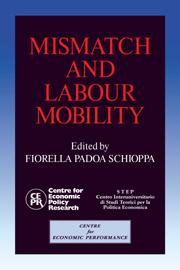Book contents
- Frontmatter
- Contents
- List of figures
- List of tables
- Preface
- Acknowledgements
- List of conference participants
- 1 A cross-country comparison of sectoral mismatch in the 1980s
- 2 Mismatch: a framework for thought
- Discussion
- 3 Match and mismatch on the German labour market
- Discussion
- 4 Mismatch in Japan
- Discussion
- 5 Mismatch and internal migration in Spain, 1962–86
- Discussion
- 6 Regional inequalities, migration and mismatch in Italy, 1960–86
- Discussion
- 7 Skill shortages and structural unemployment in Britain: a (mis)matching approach
- Discussion
- 8 Labour market tightness and the mismatch between demand and supply of less-educated young men in the United States in the 1980s
- Discussion
- 9 Skill mismatch, training systems and equilibrium unemployment: a comparative institutional analysis
- Discussion
- 10 Unemployment, vacancies and labour market programmes: Swedish evidence
- Discussion
- 11 Mismatch and labour mobility: some final remarks
- Index
1 - A cross-country comparison of sectoral mismatch in the 1980s
Published online by Cambridge University Press: 05 October 2010
- Frontmatter
- Contents
- List of figures
- List of tables
- Preface
- Acknowledgements
- List of conference participants
- 1 A cross-country comparison of sectoral mismatch in the 1980s
- 2 Mismatch: a framework for thought
- Discussion
- 3 Match and mismatch on the German labour market
- Discussion
- 4 Mismatch in Japan
- Discussion
- 5 Mismatch and internal migration in Spain, 1962–86
- Discussion
- 6 Regional inequalities, migration and mismatch in Italy, 1960–86
- Discussion
- 7 Skill shortages and structural unemployment in Britain: a (mis)matching approach
- Discussion
- 8 Labour market tightness and the mismatch between demand and supply of less-educated young men in the United States in the 1980s
- Discussion
- 9 Skill mismatch, training systems and equilibrium unemployment: a comparative institutional analysis
- Discussion
- 10 Unemployment, vacancies and labour market programmes: Swedish evidence
- Discussion
- 11 Mismatch and labour mobility: some final remarks
- Index
Summary
Foreword and summary
The idea on which the January 1990 Venice Conference on ‘Mismatch and Labour Mobility’ premised its proceedings was to verify whether the persistently high unemployment rates – observed in most countries since the first oil shock – could be explained by the growth of the frictional/structural component of unemployment, due to increasing mismatch.
Similar thoughts, inspiring many studies in this volume, have been widespread, especially in Europe, as indicated by the two following quotations. The 1990 Annual Report of the CEPS Macroeconomic Policy Group (Danthine et al., 1990, 20) states: ‘a common view is that Europe's unemployment problem is, to a significant degree, the result of a structural mismatch between the supply of, and the demand for, different skill types … Previous reports of this group have called attention to the need for greater differentials in labour costs, both regionally and across occupations if unemployment is to be kept at acceptable levels’. In turn, Burda and Wyplosz (1990, 1) add that ‘high unemployment remains a highly visible feature of the European economic landscape. The conventional wisdom that has emerged over the past fifteen years is that high unemployment rates in Europe are symptomatic of insufficient economic activity or malfunctioning labor markets. Regardless of the cause, persistence or sluggish behavior of the stocks of unemployment and employment in European countries – in contrast to the United States, Canada and Japan – is taken as prima facie evidence of declining gross hiring and firing activity and deteriorating worker mobility’.
- Type
- Chapter
- Information
- Mismatch and Labour Mobility , pp. 1 - 43Publisher: Cambridge University PressPrint publication year: 1991
- 5
- Cited by



